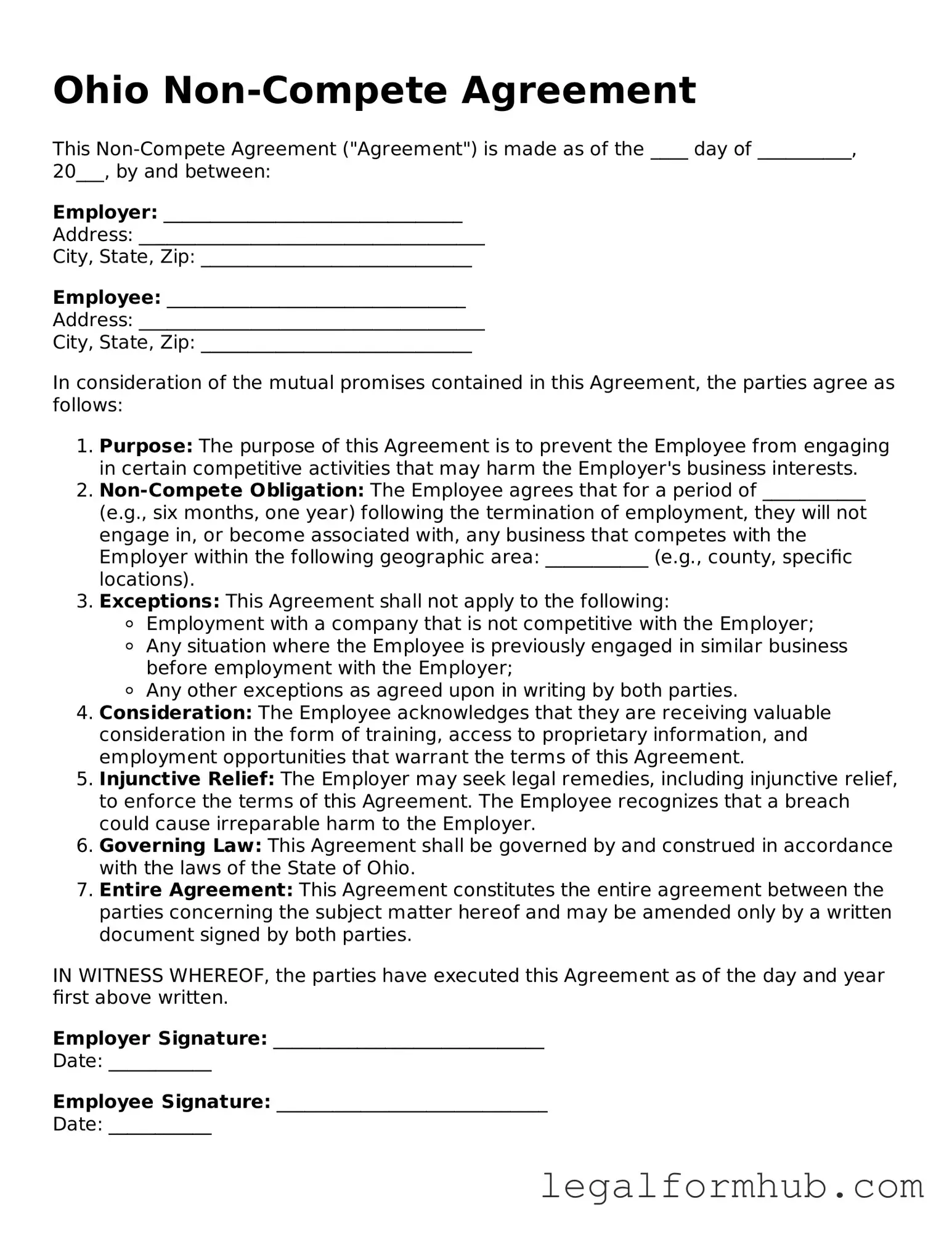The Ohio Non-compete Agreement is similar to the Employment Agreement, which outlines the terms of employment between an employer and an employee. Both documents establish mutual obligations, but while the Employment Agreement focuses on job responsibilities and compensation, the Non-compete Agreement specifically restricts the employee's ability to work for competitors after leaving the company. This ensures that sensitive business information remains protected even after the employment relationship ends.
Another document that shares similarities is the Confidentiality Agreement, often referred to as a Non-disclosure Agreement (NDA). This agreement aims to protect proprietary information from being disclosed to third parties. While the Non-compete Agreement restricts future employment opportunities, the Confidentiality Agreement safeguards sensitive information during and after employment. Both documents are essential for protecting a company's interests and maintaining its competitive edge.
The Non-solicitation Agreement is also akin to the Ohio Non-compete Agreement. This document prevents former employees from soliciting clients or employees of the former employer for a specified time after leaving the company. While the Non-compete Agreement restricts working for competitors, the Non-solicitation Agreement focuses on preserving the company's relationships with its clients and workforce, thereby ensuring continuity and stability.
Similarly, the Proprietary Information Agreement serves to protect a company's trade secrets and proprietary information. This document requires employees to acknowledge the importance of safeguarding confidential information during their employment. While it does not impose employment restrictions like the Non-compete Agreement, it complements it by ensuring that employees understand their obligation to protect sensitive information, thus reinforcing the company's overall security measures.
The Licensing Agreement bears resemblance to the Non-compete Agreement in that both involve restrictions on certain activities. A Licensing Agreement allows one party to use the intellectual property of another under specific conditions. While the Non-compete Agreement restricts employment opportunities, the Licensing Agreement governs the use of intellectual property, ensuring that the rights of the licensor are protected and that the licensee does not engage in competitive activities that could undermine the licensor's interests.
To ensure safety and legal protection during any organized activities, it is essential to understand the significance of the California Release of Liability form. By signing this document, participants acknowledge the risks involved and agree not to hold the event organizers accountable in the event of any mishaps. If you're preparing for such activities, it's crucial to have this form completed. You can easily achieve this by using the resources available at Fill PDF Forms.
The Partnership Agreement is another document that shares common ground with the Non-compete Agreement. It outlines the terms and conditions of a partnership between two or more parties. While it primarily focuses on the management and distribution of profits, it may also include non-compete clauses to protect the interests of the partnership. This ensures that partners do not engage in competing ventures that could harm the business, similar to how the Non-compete Agreement functions within an employment context.
The Franchise Agreement is also similar in that it contains provisions that restrict franchisees from competing with the franchisor. This agreement governs the relationship between the franchisor and franchisee, detailing the rights and obligations of both parties. Like the Non-compete Agreement, it aims to protect the brand and business model of the franchisor, ensuring that franchisees do not undermine the overall success of the franchise system.
The Release of Claims Agreement can be compared to the Non-compete Agreement as both involve the relinquishment of certain rights. In a Release of Claims Agreement, an employee agrees not to pursue legal claims against the employer in exchange for certain benefits, such as severance pay. While the Non-compete Agreement restricts future employment, the Release of Claims Agreement protects the employer from potential legal actions, creating a mutually beneficial arrangement at the end of the employment relationship.
Lastly, the Settlement Agreement can be likened to the Non-compete Agreement as it often includes clauses that restrict the parties from engaging in competitive activities post-settlement. This document resolves disputes between parties and typically involves compensation in exchange for certain concessions. Both agreements seek to protect the interests of the parties involved, ensuring that sensitive information and business interests remain secure after the relationship has ended.
